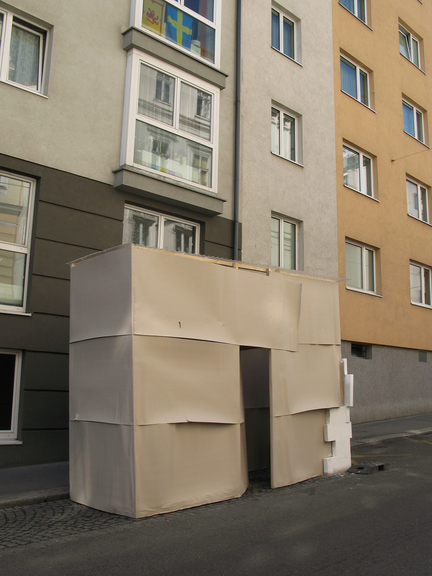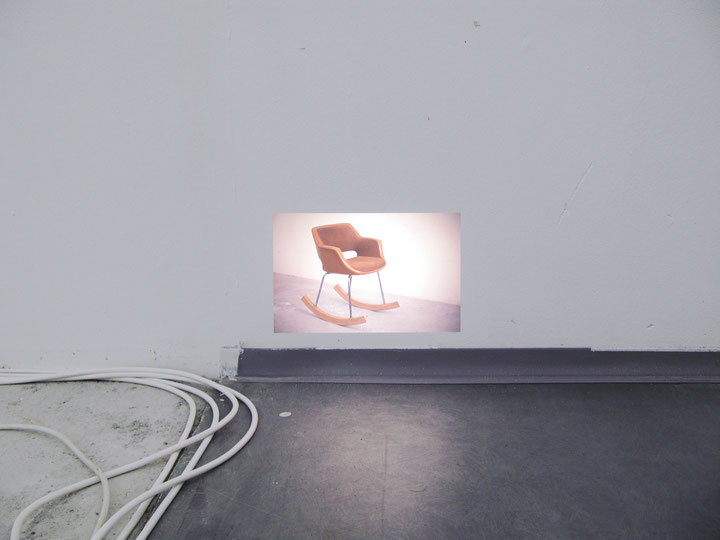Issue 4/2013 - Kunst der Verschuldung
Anything goes – everything stays
A talk with Barbara Kapusta and Stephan Lugbauer, who ran the off-space Saprophyt in Vienna
The beginning of 2013 marked the end of operations for the off-space Saprophyt, which was founded five years earlier and planned from the outset as a time-limited project. This text is the result of several discussions that Axel Stockburger had with its two operators on the occasion of his project, the last one hosted by Saprophyt.
Axel Stockburger: What made you open an art space in 2008? What was your impression of the situation at the time, and what conclusions did you draw from it?
Barbara Kapusta: First there was the space at Webgasse 29, which was made available to us for a limited period of time. We discussed different ways it could be used, for example as a studio or temporary event space. It soon became clear to us that we wanted to use this option for a special project, which would follow its own set of rules that were yet to be developed.
Stephan Lugbauer: Institutional models were out of the question. When running a gallery, you have to represent the artists in every way possible and be ready to operate with the market in mind. The costs involved in creating the kind of access offered by institutions such as art associations or museums were obviously beyond our means, and on the other hand, when you reach a certain size it may lead to further problems such as the loss of flexibility and openness in relation to less tested methods of producing and exhibiting art.
Stockburger: If we try to summarize the concept forming the basis for the highly varied exhibitions and projects hosted by Saprophyt, then it seems to me that your main concern was to focus on the process of working out exhibition settings, from their conception to their execution. Was this a crucial factor in your decision to avoid showing “finished” work, instead allowing it to be created on site?
Kapusta: Yes, this decision – which is defined by its divergence from the usual practice of a classical gallery – to use all material, and not just for displays or installations, but to really allow the entire work to remain in the room, was an integral one. On the one hand, we wanted to avoid a situation in which artists simply bring works they developed in their studios to the space and pick them up again later. On the other hand, we were also interested of course in how materials and objects that had already been used could be re-used in new constellations, in a different context. What did not happen therefore was the classical reset, which shifts an apparently neutral space back to its “clean” original state, where further artists can then leave their tracks as if on freshly fallen snow. On the contrary, over time a sort of treasure trove of different materials was accumulated and used in a variety of ways.
Lugbauer: One of our ideas was also to let the artists take part in gradually setting up the space’s necessary infrastructure. It was for this purpose that Noële Ody put together an installation that made a completely new lighting situation possible, which could be used later on. In general, we wanted to leave it to those involved to develop in cooperation with us an infrastructure that made sense for their particular project, instead of confronting them with a ready-made situation. We wanted all steps in the production process to take place on site, and for us to be involved in them. Later, in a discussion with Miriam Kathrein, the term tool box emerged, which became important to us. You can think of this as referring to the way in which all functions and services that an institution offers its artists can in turn themselves be used as artistic material. In other words, we wanted to make it possible for all those involved to interact with the institutional options available, thereby offering a type of soft surface that would perhaps present an alternative to existing models.
Stockburger: The exhibition series Projects & Assignments, for which you also released an accompanying publication, was one of the exceptional projects you realized. You asked the L.A.-based curator Andrew Berardini to collaborate on the parameters for this series. The springboard was a project by David Askevold from 1969 in which artists such as Sol Lewitt, Robert Barry and Lawrence Weiner were invited to come up with assignments for the students in Askevold’s course at the Nova Scotia College of Art & Design in Canada. Afterward, Berardini asked a selection of artists to create so-called Assignments.1 These assignments would in turn present a starting point for other artists to develop a series of projects in your space.2 I think that this example raises some interesting questions. On the one hand, in the tradition of Fluxus and happenings as well as the conceptual art of the 1960s, such assignments were developed as independent works of art, which in a sense gained their special quality due to the fact that they did not have to be realized, but were free to exist as concepts in the viewer’s imagination. Furthermore, from this it follows that artists who obey such instructions automatically find themselves within the web of artistic authorship and must behave accordingly. What does it mean, for those commissioned by you, to engage in carrying out assignments? What was their reaction?
Kapusta: We actually understood these assignments as works of art in their own right, which were to initiate the artistic production of other works or situations. This type of specification caused extremely exciting discussions, which ranged from open refusal to very complex forms of translation. Each rule allows in a sense for a certain realm of possibility which one must position oneself within. In addition, the Assignments were themselves highly varied, ranging from very clear instructions to rather poetic open forms. There were artists such as Can Gülcü and Roberta Lima who deliberately deviated from the instructions and created completely independent settings within the space. For others, these assignments were a jumping-off point in a chain of productive decisions that led to completely unforeseeable final results. Josip Novosel, for example, interpreted the instruction to have a set of female narrators reading out a series of terms for the duration of the exhibition as a wall of articles of clothing representing the speakers. These different strategies for negotiating the assignments appeared in different forms in each of the productions.
Lugbauer: Since you addressed the legacy of conceptual art earlier, I would like to say that it was also important for us to find out what happens when an abstract assignment is transferred from the immaterial realm back to a concrete, physical space with different actors in it. In this sense, the Assignments were really primarily a kind of catalyst that was used to set the entire project into motion and to make different practices visible. The fact that some of the artists evaded the instructions entirely, or saw them as restrictions that were to be overcome, formed an important part of this process.
This circumstance in fact applied to all points of our program. After all, the concept of Saprophyt is in general an assignment in and of itself, one that is very dominant. Personally, I was most fascinated by the approaches that, out of apparent refusal to obey, seemed to undertake radical reorientations within our system of rules, for instance Octavian Trauttmansdorff’s contribution, which you might say made negative reference to the pre-existing material. He simply built a smaller room within the exhibition space as well as another one outside on the street, both of which obscured all the material left over from preceding presentations. At the same time, however, it was all still there, of course. A similar approach was taken by Josef Dabernig for his cinema cube, likewise taking up and expanding on the institutional assignment.
Stockburger: In this connection I am interested above all in the apparent friction between the rules and breaking them, which can be most productive. If we were to understand institutions as collections of procedural instructions and forms, then these processes are exactly what you were focusing on. I find the metaphor of a game very useful in this context. For instance, the French theorist Roger Caillois differentiated between ludus, the rule-bound game, and paidia, a freer form that allows the rules to be developed and rejected throughout the playing process. Applied to your projects, one might say that to a certain extent they went down the path of ludus via paidia and onward to new forms of ludus in the sense that they created templates for processes that followed. Finally, however, there’s another aspect that interests me. Against the backdrop of the growing number of art events and their media communication, social networks seem to have become more and more important – what significance do you attach to these forms?
Kapusta: Naturally, in the four years that Saprophyt existed, a type of social network gradually developed and established itself around this form of work. You illustrated this very precisely in your poster series, which uses the names of those involved as material. I must say, however, that this process was certainly not strategically planned. Especially at the beginning, our decisions were highly improvised – even those regarding communication. Unlike many other institutions and galleries, we kept our publicity minimal. We also tried, perhaps in reference to the increasingly perfected PR strategies deployed by many off-spaces, to create a contrast to all those images with hundreds of “likes.” Something like what we did can only develop if you take the time to enter into a real dialogue, one that even permits dissonances. For this purpose, it was absolutely necessary to have a physically existing space.
Lugbauer: That is a crucial point; the location itself was naturally of central importance. Nonetheless, as suggested by the term “saprophyte” – which denotes a type of organism, a fungus, that spreads through spores and is therefore nomadic – we would like this form to spread beyond the realm of concrete locations. The poster series, which can be seen across the city, is surely a first step in this direction. This is also a kind of dispersal of spores throughout the public and private spheres. We are now thinking about what else could be done with Saprophyt, while maintaining our interest in making artistic processes visible. The ideas range from media forms such as radio to other event formats we are currently considering. Saprophyt was always the sum of all actors and processes that became visible before this background, and we continue to work on developing this kind of access in different forms.
Translated by Jennifer Taylor
1 Liz Glynn, Scoli Acosta, Natascha Sadr Haghighian, Anton Vidokle, Robert Barry, John Baldessari.
2 Can Gülcü, Roberta Lima, Christian Egger, Jakob Lena Knebl, Noële Ody, Josip Novosel, Nathalie Koger.


